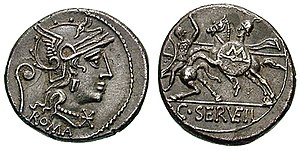Gaius Servilius Vatia: Difference between revisions
m added category using AWB |
Tom.Reding (talk | contribs) m +{{Authority control}} (2 IDs from Wikidata); WP:GenFixes & cleanup on |
||
| (25 intermediate revisions by 18 users not shown) | |||
| Line 1: | Line 1: | ||
{{Short description|2nd-century BCE Roman politician}} |
|||
| ⚫ | |||
[[File:Servilia6.jpg|thumb|300px|[[Denarius]] of Gaius Servilius Vatia, 127 BC. The obverse depicts a head of [[Roma (mythology)|Roma]]; the [[lituus]] behind her head refers to Pulex Geminus' augurate in 211 BC. The reverse depicts Marcus Servilius Pulex Geminus, identified by the 'M' on his shield.<ref name=":0">Crawford, ''Roman Republican Coinage'', p. 289.</ref>]] |
|||
| ⚫ | |||
Vatia belonged to the [[Gens (Roman)|gens]] [[Servilia gens|Servilia]], which was initially [[Patrician (ancient Rome)|patrician]], but went over to the [[plebeians]] during the [[Second Punic War]]. He was probably the son of Marcus Servilius, a [[Pontiff|pontifex]] in 170 and the grandson of [[Marcus Servilius Pulex Geminus]], consul in 202, famous for his victories in single combat.<ref>Münzer, ''RE'', 2nd series, vol. IV, pp. 1764–1766, 1811, 1812.</ref><ref name=":1">Crawford, ''Roman Republican Coinage'', pp. 270, 271.</ref> He married Caecilia, a daughter of [[Quintus Caecilius Metellus Macedonicus]], who was one of the most important politicians of the time after his victory during the [[Fourth Macedonian War]] in 148 BC. |
|||
He married Caecilia Metella, born c. [[170 BC]], daughter of [[Quintus Caecilius Metellus Macedonicus]]. By her he had: |
|||
* [[Publius Servilius Vatia Isauricus]] |
|||
Vatia was [[Triumvir Monetalis|triumvir monetalis]] in 127. He minted [[Denarius|denarii]] depicting one of the duels of his grandfather Pulex Geminus.<ref name=":0" /> |
|||
==See also== |
|||
* [[Servilia (gens)]] |
|||
He then served in the Greek East as [[praetor]] or [[Promagistrate|propraetor]], probably in [[Macedonia (Roman province)|Macedonia]], because he was honoured with a statue in [[Olympia, Greece|Olympia]] by the city of [[Elis (regional unit)|Elis]].<ref>Münzer, ''Aristocratic Parties'', pp. 440, 441 (note 54).</ref><ref>Broughton, vol. II, p. 465.</ref> |
|||
==Further reading== |
|||
* Manuel Dejante Pinto de Magalhães Arnao Metello and João Carlos Metello de Nápoles, "Metellos de Portugal, Brasil e Roma", Torres Novas, 1998 |
|||
Vatia had three sons. The elder son Gaius was praetor in 102, while the second one Marcus was likewise moneyer in 100. His third son [[Publius Servilius Vatia Isauricus (consul 79 BC)|Publius]] was by far the most famous. He reached the [[Roman consul|consulship]] in 79 BC, then held a long command in [[Cilicia (Roman province)|Cilicia]] in order to fight the [[Cilician pirates|pirates]]. He received a [[Roman triumph|triumph]] and the [[agnomen]] Isauricus thanks to his victory there.<ref>Broughton, vol. II, p. 105.</ref><ref name=":1" /> |
|||
{{Uncategorized|date=August 2010}} |
|||
==References== |
|||
| ⚫ | |||
{{reflist}} |
|||
| ⚫ | |||
==Bibliography== |
|||
{{Ancient-Rome-bio-stub}} |
|||
* [[Thomas Robert Shannon Broughton|T. Robert S. Broughton]], ''The Magistrates of the Roman Republic'', American Philological Association, 1951–1952. |
|||
{{historian-stub}} |
|||
* [[Michael Crawford (historian)|Michael Crawford]], ''Roman Republican Coinage'', Cambridge University Press, 1974. |
|||
*[[Friedrich Münzer]], ''Roman Aristocratic Parties and Families'', translated by Thérèse Ridley, Johns Hopkins University Press, 1999 (originally published in 1920). |
|||
*[[August Pauly]], [[Georg Wissowa]], [[Friedrich Münzer]], ''et alii'', ''[[Realencyclopädie der Classischen Altertumswissenschaft]]'' (abbreviated ''RE''), J. B. Metzler, Stuttgart, 1894–1980. |
|||
{{Authority control}} |
|||
| ⚫ | |||
| ⚫ | |||
[[Category:Year of birth unknown]] |
|||
[[Category:2nd-century BC Romans]] |
|||
[[Category:Servilii Vatiae]] |
|||
Latest revision as of 08:42, 13 December 2023

Gaius Servilius Vatia was a politician of the Roman Republic in the second half of the 2nd century BC.
Vatia belonged to the gens Servilia, which was initially patrician, but went over to the plebeians during the Second Punic War. He was probably the son of Marcus Servilius, a pontifex in 170 and the grandson of Marcus Servilius Pulex Geminus, consul in 202, famous for his victories in single combat.[2][3] He married Caecilia, a daughter of Quintus Caecilius Metellus Macedonicus, who was one of the most important politicians of the time after his victory during the Fourth Macedonian War in 148 BC.
Vatia was triumvir monetalis in 127. He minted denarii depicting one of the duels of his grandfather Pulex Geminus.[1]
He then served in the Greek East as praetor or propraetor, probably in Macedonia, because he was honoured with a statue in Olympia by the city of Elis.[4][5]
Vatia had three sons. The elder son Gaius was praetor in 102, while the second one Marcus was likewise moneyer in 100. His third son Publius was by far the most famous. He reached the consulship in 79 BC, then held a long command in Cilicia in order to fight the pirates. He received a triumph and the agnomen Isauricus thanks to his victory there.[6][3]
References[edit]
Bibliography[edit]
- T. Robert S. Broughton, The Magistrates of the Roman Republic, American Philological Association, 1951–1952.
- Michael Crawford, Roman Republican Coinage, Cambridge University Press, 1974.
- Friedrich Münzer, Roman Aristocratic Parties and Families, translated by Thérèse Ridley, Johns Hopkins University Press, 1999 (originally published in 1920).
- August Pauly, Georg Wissowa, Friedrich Münzer, et alii, Realencyclopädie der Classischen Altertumswissenschaft (abbreviated RE), J. B. Metzler, Stuttgart, 1894–1980.
